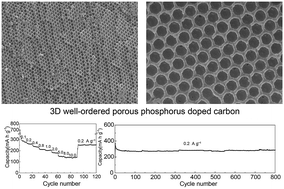3D well-ordered porous phosphorus doped carbon as an anode for sodium storage: structure design, experimental and computational insights†
Abstract
Carbon materials with a novel structure have been considered to be potential anodes for sodium ion batteries (SIBs). However, the practical utilization of a carbon electrode for SIBs suffers from low initial coulombic efficiency and poor ion diffusion kinetics. Moreover, the sodium storage mechanism still remains controversial. Herein, well-ordered 3D porous phosphorus doped carbon was designed and developed as an anode material for SIBs, which delivers an excellent reversible capacity of 270 mA h g−1 at 0.2 A g−1 and a good rate capability of 140 mA h g−1 even at 10 A g−1. The correlation of experimental results and theoretical calculation confirms that phosphorus doping into the carbon material could increase the interlayer distance, enhance the adsorption of sodium ions and modify the electronic structure, and thus can promote the efficient sodium insertion/extraction and charge transfer kinetics. Moreover, the interconnected porous carbon structure is facile to promote the permeation of the electrolyte for transportation and diffusion of ions and electrons. This synthetic strategy provides an efficient and simple approach to prepare well-ordered 3D porous heteroatom-doped carbon for SIBs and other energy storage devices.



 Please wait while we load your content...
Please wait while we load your content...